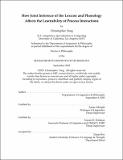How Joint Inference of the Lexicon and Phonology Affects the Learnability of Process Interactions
Author(s)
Yang, Christopher
DownloadThesis PDF (800.6Kb)
Advisor
Albright, Adam
Feldman, Naomi H.
Terms of use
Metadata
Show full item recordAbstract
Contemporary phonological research has increasingly become interested in exploring the topic of learnability through the use of computational models. However, many of the proposed models lack one or more of the following properties. (1) Many models do not consider the effect of the lexicon at all on performance, and those that do fail to consider the effect contextual allomorphy has on performance. (2) Many models characterize learnability in terms of the algorithmic implementation of search, rather than a more principled relationship between the data and the hypothesis space. These properties are critically relevant when it comes to the learnability of process interactions. The experimental literature has demonstrated that artificial languages exhibiting patterns generated from certain process interactions are more likely to be successfully reproduced and generalized by participants than others (Ettlinger 2008; Kim 2012; Brooks, Pajak, & Baković 2013; Prickett 2019). The historical literature has likewise noted that surface patterns generated from particular process interactions are more likely to change in systematic ways than others, including lexicalization, in which an alternation is encoded into the lexicon instead of the phonology, and reanalysis, in which a surface generalization is lost or changed entirely (Kiparsky 1968, 1971). Each of these hypotheses make different predictions when generating forms not seen during training. In this dissertation, I make the following contributions. (1) I propose a novel noisy-channel model of morphophonological learning. This model jointly infers a weighted space of consistent and nearly consistent lexicons and grammars from labelled, unparsed surface data. Predictions are generated given the entirety of the inferred weighted space. (2) I compare the predictions of the model to the results two artificial language learning experiments, which, despite involving the same underlying processes, produced contradictory results. I show that the model is able to achieve the results of both experiments under a unified account: the generalizability of a pattern is determined by the number of hypotheses compatible or nearly compatible with that pattern.
Date issued
2023-09Department
Massachusetts Institute of Technology. Department of Linguistics and PhilosophyPublisher
Massachusetts Institute of Technology